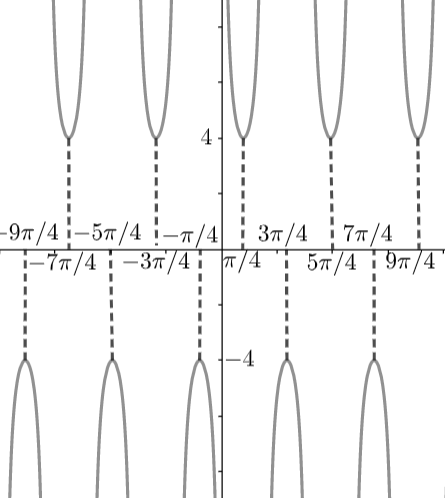
How do you graph $y=4\csc 2x$?
Answer
540.3k+ views
Hint: First compare the function $y=4\csc 2x$ with the base function. Find the period and frequency of the function. Then take some different ‘y’ values for corresponding ‘x’ values and plot the graph.
Complete step-by-step solution:
$y=4\csc 2x$ is a trigonometric function of the base function $y=\csc x$.
As we know $\csc x$ is the reciprocal of $\sin x$, so $\csc x$ will not be defined at the points where $\sin x$ is 0. Hence, the domain of $\csc x$ will be $R-n\pi $, where ‘R’ is the set of real numbers and ‘n’ is an Integers. Similarly, the range of cosec x will be $R-\left( -1,1 \right)$. Since, $\sin x$ lies between $\left( -1,1 \right)$, so $\csc x$ can never lie in the region of $\left( -1,1 \right)$.
Now, considering our equation $y=4\csc 2x$
Here the range of the function will be 4 times from that of $y=\csc x$
Again as we know the period of $\csc x=2\pi $, so the period of $y=4\csc 2x$ will be$=\dfrac{2\pi }{\left| 2 \right|}=\pi $
And the frequency$=\dfrac{1}{\pi }$ (as frequency is the reciprocal of time period)
For the graph we have to take some different values of ‘y’ for corresponding ‘x’ values
Taking these values of ‘x’ and ‘y’ the graph can be drawn as

Note: The base function of $y=4\csc 2x$ is $y=\csc x$. From the above graph, we can conclude that the graph of the function $\csc x$ does not have a maximum or a minimum value. The function goes to infinity periodically and is symmetric with the origin.
Complete step-by-step solution:
$y=4\csc 2x$ is a trigonometric function of the base function $y=\csc x$.
As we know $\csc x$ is the reciprocal of $\sin x$, so $\csc x$ will not be defined at the points where $\sin x$ is 0. Hence, the domain of $\csc x$ will be $R-n\pi $, where ‘R’ is the set of real numbers and ‘n’ is an Integers. Similarly, the range of cosec x will be $R-\left( -1,1 \right)$. Since, $\sin x$ lies between $\left( -1,1 \right)$, so $\csc x$ can never lie in the region of $\left( -1,1 \right)$.
Now, considering our equation $y=4\csc 2x$
Here the range of the function will be 4 times from that of $y=\csc x$
Again as we know the period of $\csc x=2\pi $, so the period of $y=4\csc 2x$ will be$=\dfrac{2\pi }{\left| 2 \right|}=\pi $
And the frequency$=\dfrac{1}{\pi }$ (as frequency is the reciprocal of time period)
For the graph we have to take some different values of ‘y’ for corresponding ‘x’ values
| x | $\dfrac{\pi }{4}$ | $\dfrac{3\pi }{4}$ | $\dfrac{5\pi }{4}$ | $\dfrac{7\pi }{4}$ | $\dfrac{9\pi }{4}$ |
| y | 4 | $-4$ | 4 | $-4$ | 4 |
Taking these values of ‘x’ and ‘y’ the graph can be drawn as

Note: The base function of $y=4\csc 2x$ is $y=\csc x$. From the above graph, we can conclude that the graph of the function $\csc x$ does not have a maximum or a minimum value. The function goes to infinity periodically and is symmetric with the origin.
Recently Updated Pages
Master Class 12 Economics: Engaging Questions & Answers for Success

Master Class 12 Maths: Engaging Questions & Answers for Success

Master Class 12 Biology: Engaging Questions & Answers for Success

Master Class 12 Physics: Engaging Questions & Answers for Success

Master Class 8 Maths: Engaging Questions & Answers for Success

Class 8 Question and Answer - Your Ultimate Solutions Guide

Trending doubts
What is meant by exothermic and endothermic reactions class 11 chemistry CBSE

10 examples of friction in our daily life

One Metric ton is equal to kg A 10000 B 1000 C 100 class 11 physics CBSE

1 Quintal is equal to a 110 kg b 10 kg c 100kg d 1000 class 11 physics CBSE

Difference Between Prokaryotic Cells and Eukaryotic Cells

What are Quantum numbers Explain the quantum number class 11 chemistry CBSE




